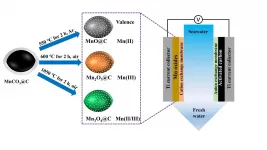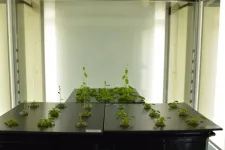(Press-News.org) Researchers at the University of Adelaide are concerned video sharing platforms such as YouTube could be contributing to the normalisation of exotic pets and encouraging the exotic pet trade.
In a study, published in PLOS ONE, researchers analysed the reactions of people to videos on YouTube involving human interactions with exotic animals and found those reactions to be overwhelmingly positive.
The researchers analysed the reactions - via text and emoji usage - in comments posted on 346 popular videos starring exotic wild cats and primates in 'free handling situations'.
These situations involved exotic animals interacting with humans or other animals, such as domestic cats and dogs. The videos examined received more than a million views and the comments posted were made between 2006 and October 2019.
First author and final year veterinary medicine student at the University of Adelaide, Georgia Moloney, said, while YouTube is not the only media platform portraying images of 'unnatural interactions' with exotic animals, it is the number one video sharing platform globally and presently the third largest social media platform overall.
"The types of interactions we observed in the videos analysed on YouTube included monkeys in nappies like children, primates as pets and pet tigers chained up and interacting with people on suburban front lawns,'' she said.
"In addition to comments along the lines of 'Isn't that cute', we found that people also indicated they wanted to be close to the animal and have a similar interaction of their own.
"This is of concern because it could indicate that people think these interactions are not only normal and okay, but desirable, and could support the exotic pet trade."
The only change in sentiment observed in the study occurred in 2015, when a negative trend was observed in reaction to videos featuring primates. The researchers say this could be partly attributed to a 2015 International Animal Rescue campaign to stop cruelty against the slow loris, titled, 'Tickling is Torture'.
"The negative trend we observed in comments on primate videos in 2015 could be connected to the 'Tickling is Torture' campaign, and demonstrates the power of social media and the role it can play in preventing animal cruelty and exploitation,'' Ms Moloney said.
The exotic pet trade is a global problem with the videos in the study uploaded from all over the world.
"We saw content uploaded from countries within all six continents. The illegal wildlife trade is a bigger problem than people realise.
"In Australia, for example, border security continues to see all sorts of native reptiles being smuggled out of our country."
Study leader, Dr Anne-Lise Chaber from the University of Adelaide School of Animal and Veterinary Sciences, who has been examining the exotic pet and illegal wildlife trade since 2008, said, while YouTube has policies outlining expectations and limitations of content published, they rely heavily on the public to report breaches and illegal content.
"Current policies rely on the public to identify what is harmful or distressing to the animal, and yet people may not have the knowledge to do that," Dr Chaber said.
"A slow loris which appears to be smiling when tickled in a video is neither violent nor graphic content and therefore it's left to the viewer to identify this sign of distress and report the video."
Dr Chaber adds: "One way YouTube could play a more active role in educating the public about what is inappropriate is by embedding an icon on videos which when clicked take people to important information about the animal.
"Education is key but this needs to go hand-in-hand with improved policies and reporting systems."
The researchers say further improvements to YouTube's policies and reporting systems could include software to automatically detect key terms such as species names within video titles or descriptions and flag them for immediate review. Also, artificial intelligence systems to accurately identify threatened exotic species depicted in content and inform the public about their conservation status before permitting viewing, similar to Instagram's Wildlife Alert System.
INFORMATION:
Public use of parks and reserves increased only slightly during last year's COVID-19 national lockdown despite gyms and sports facilities shutting down, a University of Queensland study found.
UQ School of Biological Sciences PhD candidate Violeta Berdejo-Espinola surveyed 1000 people in Brisbane, measuring their use of urban green space and the benefits people associated with visiting the areas during lockdown.
"People all around Brisbane, myself included, noticed a boom in park use in 2020, but while more people ventured into local parks, many folks were left indoors," Ms Berdejo-Espinola said.
"Thirty-six ...
Professor YAO Huajian's research group from the School of Earth and Space Sciences of the University of Science and Technology of China (USTC), in cooperation with Dr. Piero Poli from Grenoble-Alpes University of France, combined the unique resolution reflected body waves (P410P and P660P) retrieved from ambient noise interferometry with mineral physics modeling, to shed new light on transition zone physics. Relevant work was published in Nature Communications.
The subduction of oceanic slabs is an important process of the earth's internal material circulation. Studying the ...
Recently, the researchers from Institute of Solid State Physics, Hefei Institutes of Physical Science (HFIPS) of the Chinese Academy of Sciences, by using valence engineering, developed three manganese oxides as electrodes with different Mn valences for high-performance capacitive desalination.
Reverse osmosis and thermal distillation are widely used to treat salt water with high salt concentration, but they have disadvantages including high energy consumption and high cost.
As an alternative method, capacitive deionization (CDI) technology can remove charged ions ...
University of Virginia School of Medicine researchers have shed new light on how our brains develop, revealing that the very last step in cell division is crucial for the brain to reach its proper size and function.
The new findings identify a potential contributor to microcephaly, a birth defect in which the head is underdeveloped and abnormally small. That's because the head grows as the brain grows. The federal Centers for Disease Control estimates that microcephaly affects from 1 in 800 children to 1 in 5,000 children in the United States each year. The condition is associated with learning disabilities, developmental delays, ...
Waking up just one hour earlier could reduce a person's risk of major depression by 23%, suggests a sweeping new genetic study published May 26 in the journal JAMA Psychiatry.
The study of 840,000 people, by researchers at University of Colorado Boulder and the Broad Institute of MIT and Harvard, represents some of the strongest evidence yet that chronotype--a person's propensity to sleep at a certain time --influences depression risk.
It's also among the first studies to quantify just how much, or little, change is required to influence mental health. ...
Until now, competing types of robotic hand designs offered a trade-off between strength and durability. One commonly used design, employing a rigid pin joint that mimics the mechanism in human finger joints, can lift heavy payloads, but is easily damaged in collisions, particularly if hit from the side. Meanwhile, fully compliant hands, typically made of molded silicone, are more flexible, harder to break, and better at grasping objects of various shapes, but they fall short on lifting power.
The DGIST research team investigated the idea that a partially-compliant ...
Australian scientists have found what could prove to be a new and effective way to treat a particularly aggressive blood cancer in children.
Acute lymphoblastic leukaemia, or ALL, is the most common cancer diagnosed in children. Despite dramatic improvements in the survival of children with ALL over past several decades, children who develop 'high risk' ALL - subtypes that grow aggressively and are often resistant to standard treatments - often relapse, and many of these children die from their disease.
One common type of high-risk ALL for which new therapies are urgently needed is 'Philadelphia chromosome-like ALL' (Ph-like ALL), named for its similarity ...
Scientists from Japan, Europe and the USA have described a pathway leading to the accelerated flowering of plants in low-nitrogen soils. These findings could eventually lead to increases in agricultural production.
Nitrogen is one of the three macronutrients required by plants for growth and development, along with phosphorus and potassium. Nitrogen-rich condition induces plant growth, particularly the growth of stems and leaves, while delaying flowering. On the other hand, in some plants, low-nitrogen conditions lead to a change from growth mode to reproductive mode, therefore accelerating flowering. However, the molecular mechanisms that regulate flowering under these conditions are not known.
A team of scientists led by Associate ...
Corona Virus Disease (COVID -19) patients primarily appear with respiratory issues and viral pneumonia. The patients may also present cardiovascular issues includes early signs of acute myocardial injury. The researchers from Sohag University, Egypt, found that cardiac troponin I (cTnI) can prove to be a gold-standard biomarker for necrosis and myocardial risk assessment in COVID-19 sufferers.
The researchers aimed to assess the prognostic value of cTnI in COVID-19 sufferers. The study included ninety-two COVID-19 patients admitted in the El Helal ...
UNIVERSITY PARK, Pa. -- The microscopic algae that live inside and provide nutrients to their reef-building coral hosts may be evolving in tandem with the corals they inhabit, so each partner is fine-tuned to meet one another's needs. A new study by Penn State biologists reveals that genetic differences within a species of these microalgal symbionts correspond to the coral species they inhabit, a discovery that could have implications for the conservation of these endangered corals.
"Acroporid corals are some of the primary reef-building species in the Caribbean, providing protection to coastlines and habitat for economically important species," said Iliana Baums, professor of biology at Penn State and leader of the research team. "However, these corals are critically ...






